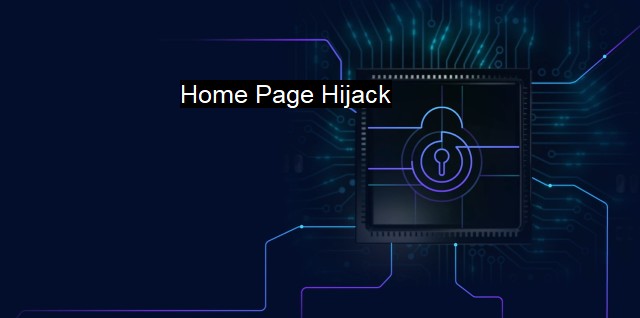What is Home Page Hijack?
Home Page Hijacking: How Malware and Phishing Threaten Cybersecurity in the Digital Age
"Home Page Hijack" is a type of cyber threat prevalent in today's digital world. To understand how a home page hijack functions and what it essentially means, one has to start from the basics. A home page significantly is the direct link to a website's main page, generally the first page that the web surfer views when they access a specific domain. A Home Page Hijack means that an intruder illicitly changes your browser's default home page. This unauthorized modification happens without the user's direct consent and generally redirects to malicious websites designed to perform deceptive functions.Home Page Hijack typically unfolds as a type of browser hijacking where an unauthorized change is forced onto a web browser to alter the browser's settings without obtaining the user's permission. This form of cyber attack gains its name due to its unique setup. The hijack happens, making the primary and the most read page for users- the home page, the victim. There are several adverse effects of the home page hijacking, starting from annoyance for the user due to unwanted unwarranted settings changes to the Prima facie cause.
From a cybersecurity perspective, Home Page Hijack creates a possible vulnerability into a secure IT system to exploit godsends and allow influx unsolicited programs that spy on user activity, therefore, stealing sensitive data and information or retarget the user's computer into a lazy zombie for subsequent spamming activities and Distributed Denial of Service (DDoS) attacks.
The home page hijack is usually associated with malicious browser plugins and third-party software downloads that take the user by surprise, altering settings during their installation process. Notwithstanding, the home page hijack may also result from deceptive phishing attacks, which trick users into authorizing these changes unknowingly. The alteration of the home page can lead to spam-related pop-ups, direct users to potentially malicious or inappropriate websites, and achieve it through the unauthorized download of illicit software onto the affected device. It can result in the risk of malware disturbance with the computer's sensitive files and resources.
In terms of data protection, Home Page Hijack creates a distinct entrée point where it portrays the user's vital qualifications for online banking, shopping and other transactions, credit card details, personal email, etc., within easy contact of cybercriminals, spurring identity theft concerns.
On a far more personal level, the failure of conventional antivirus tools paradoxically signifies a significant attribute factor of home page hijacking. Antivirus tools often tend to heavily target threats perceived by their coding language and tend to overlook browser settings changes and similar concerns. As a result, the altercations ordained by home page hijacking often go unnoticed until repercussions surface in the form of dysfunctions or major incidents.
In order to tackle the insidious dragon of home page hijack, it is prudent to invest in robust cybersecurity solutions that include advanced real-time protection and feature behavioral-based identification abilities. Regularly updating the browser and operating system offer security patches and updates to tackle malicious alterations. More so, a decisive archival activity is to exercise caution during the installation of new software applications, paying attention to the over-all process to ensure no modifications incur without direct consent.
Home Page Hijack presents itself as a unique subsidiary of cyber threats. With its masterful exploitation of authorized changes in home page settings and subjugation of obtrusive software, it models a prime example for hackers to tap into data and manipulate IT Systems for their purpose. Many individuals may disregard its severity. understand that it lubricates the pathway for other severe attacks to infiltrate any system. Hence, it necessitates awareness to execute prevention efficiently and protect one's cyber realm against the possible repercussions.

Home Page Hijack FAQs
What is a Home Page Hijack?
A Home Page Hijack occurs when malware or a virus takes over your web browser's home page and sets it to a different page. The hijacker does this without your knowledge or permission.How does Home Page Hijacking happen?
Home Page Hijacking happens when you unknowingly download malware or a virus onto your computer. The malware then alters your browser settings, including your home page.What are the risks of Home Page Hijacking?
Home Page Hijacking can lead to serious cybersecurity risks such as data theft, identity theft, and financial fraud. Hijackers can use your web browser to collect sensitive data, install malicious software, or redirect you to fake web pages.How can I prevent Home Page Hijacking?
You can prevent Home Page Hijacking by using an antivirus software that can detect and remove malware and viruses. It's also important to keep your software up-to-date and to avoid downloading unknown software or clicking on suspicious links. Additionally, regularly scanning your computer for viruses and malware can also help prevent Home Page Hijacking.| | A | | | B | | | C | | | D | | | E | | | F | | | G | | | H | | | I | | | J | | | K | | | L | | | M | |
| | N | | | O | | | P | | | Q | | | R | | | S | | | T | | | U | | | V | | | W | | | X | | | Y | | | Z | |
| | 1 | | | 2 | | | 3 | | | 4 | | | 7 | | | 8 | | |||||||